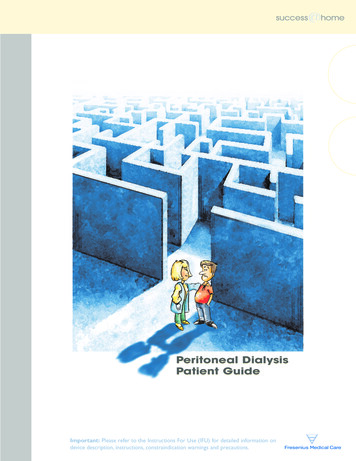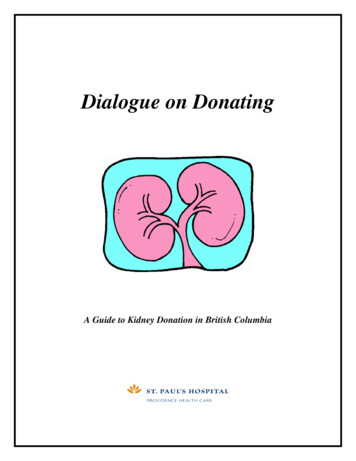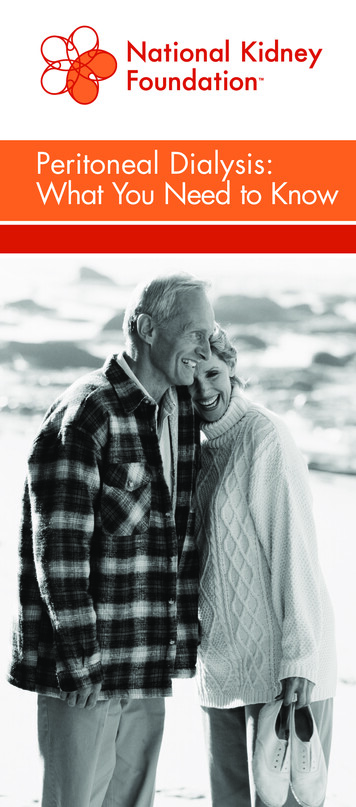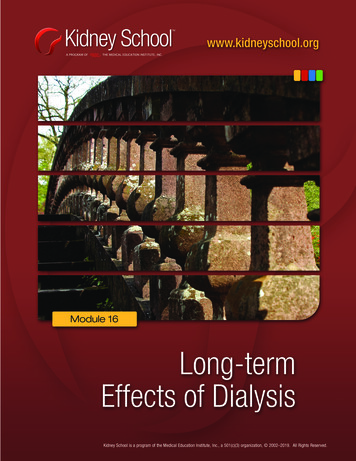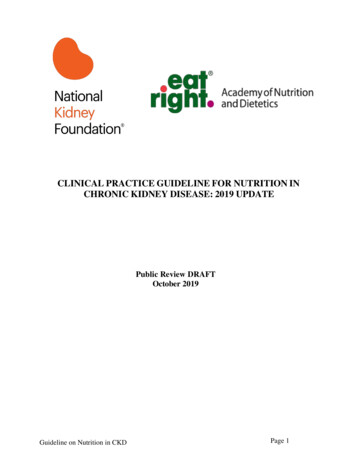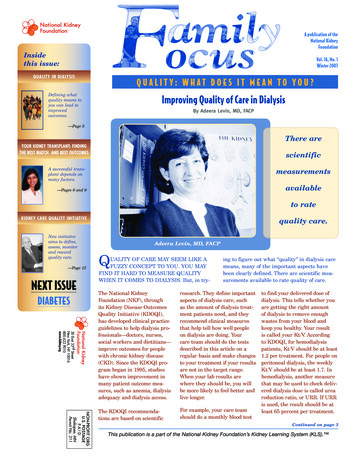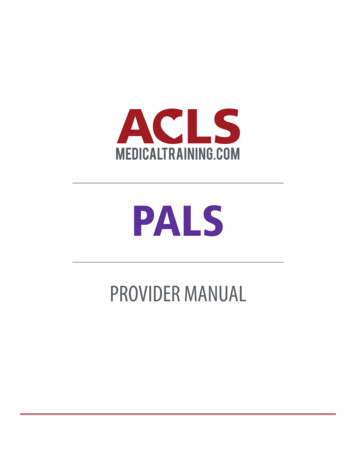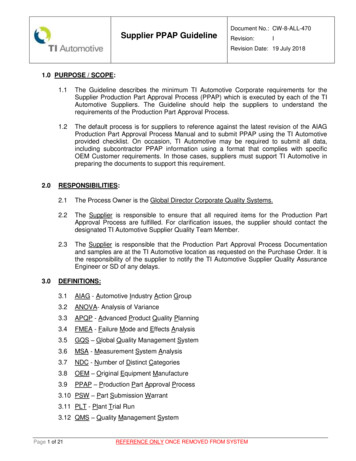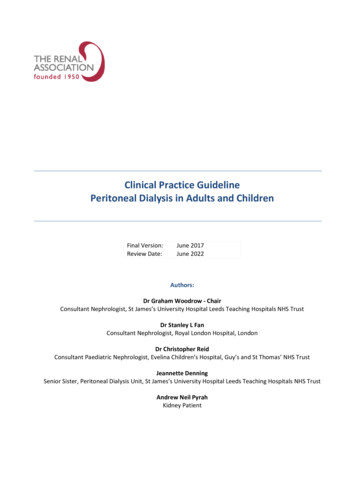
Transcription
Clinical Practice GuidelinePeritoneal Dialysis in Adults and ChildrenFinal Version:Review Date:June 2017June 2022Authors:Dr Graham Woodrow - ChairConsultant Nephrologist, St James’s University Hospital Leeds Teaching Hospitals NHS TrustDr Stanley L FanConsultant Nephrologist, Royal London Hospital, LondonDr Christopher ReidConsultant Paediatric Nephrologist, Evelina Children’s Hospital, Guy’s and St Thomas’ NHS TrustJeannette DenningSenior Sister, Peritoneal Dialysis Unit, St James’s University Hospital Leeds Teaching Hospitals NHS TrustAndrew Neil PyrahKidney Patient
EndorsementsThe National Institute for Health and Care Excellence (NICE) has accredited the process used by the RenalAssociation to produce its Clinical Practice Guidelines. Accreditation is valid for 5 years from January 2017.More information on accreditation can be viewed at www.nice.org.uk/accreditationMethod used to arrive at a recommendationThe recommendations for the first draft of this guideline resulted from a collective decision reached byinformal discussion by the authors and, whenever necessary, with input from the Chair of the Clinical PracticeGuidelines Committee. If no agreement had been reached on the appropriate grading of a recommendation, avote would have been held and the majority opinion carried. However this was not necessary for thisguideline.Conflicts of Interest StatementAll authors made declarations of interest in line with the policy in the Renal Association Clinical PracticeGuidelines Development Manual. Further details can be obtained on request from the Renal Association.Renal Association Clinical Practice Guideline - Peritoneal Dialysis – June 20172
Table of Contents1.Introduction . 42.Summary of Clinical Practice Guidelines for Peritoneal Dialysis . 53.Summary of Audit Measures for Peritoneal Dialysis . 104.Rationale for clinical practice guidelines for Peritoneal Dialysis . 115.Lay Summary. 386.Acknowledgements . 38Appendix1. Assessment of Membrane Function in Adult PD Patients . 392. Measurement of Solute Clearance in Adult PD Patients . 393. Estimating Total Ultrafiltration . 404. Assessment of Membrane Function in Paediatric PD Patients Estimating Total Ultrafiltration . 415. Measurement of Solute Clearance in Paediatric PD Patients . 41Renal Association Clinical Practice Guideline - Peritoneal Dialysis – June 20173
1. IntroductionThese guidelines cover the organisation and performance of peritoneal dialysis as a treatment for kidneypatients, including infants and children. It includes prevention and treatment of complications. It does notinclude factors involved in the choice of peritoneal dialysis compared to other options for patients with stage 5chronic kidney disease. This document is intended for use by any member of the health care team engaged inthe care of kidney patients treated with peritoneal dialysis.Peritoneal dialysis (PD) is long established as a major option for renal replacement therapy in patients withend-stage renal disease. It is an important part of an integrated service for renal replacement therapy that isfrequently selected by patients as their preferred initial mode of therapy and is a therapeutic option forpatients wishing or needing to swap from HD and after renal transplant failure. PD is the best option forinfants and small children. NICE Clinical Guideline 125 (2011) recommends PD as the initial dialysis treatmentof choice of chronic kidney disease stage 5 for children aged 2 years or older, people with residual renalfunction and adults without significant associated comorbidities.For the first time, this Renal Association guideline includes recommendations relating to PD in children.Recommendations in this guideline will refer to both adult and paediatric patients, except where therecommendation specifies one of these patient groups or provides alternative recommendations to them.This guideline is an update of the PD module published on-line on the Renal Association website,www.renal.org in 2010. The English language literature was searched in December 2016 to identify relevantarticles on PD published between 2008 and 2016 including: Medline search using ‘peritoneal dialysis’ combined with relevant terms from each of the sections - Equipment & Resources, Training & Catheter Insertion, Dialysis Clearance, Ultrafiltration & Overhydration,Infections, Peritonitis, Exit Site Infections, Renal Osteodystrophy & Diabetes Mellitus, EncapsulatingPeritoneal Sclerosis, Assisted Peritoneal Dialysis, Icodextrin, Peritoneal Membrane, Urgent Start andBiocompatible SolutionsCochrane Database of Systematic ReviewsReview of other national / international PD clinical guidelinesIdentification of further articles quoted in identified papersReview of Peritoneal Dialysis International’s table of contents for articles relating to the content of theguidelinesSearches within the major renal journals (Journal of the American Society of Nephrology, Clinical Journal ofthe American Society of Nephrology, Nephrology Dialysis Transplantation, Kidney International, AmericanJournal of Kidney Diseases) for articles with ‘peritoneal dialysis’ in the title/abstractThe recommendations in this guideline have been harmonised with other PD guidelines whenever possibleand the recommendations to follow international PD or other Renal Association guidelines have not beengraded.Renal Association Clinical Practice Guideline - Peritoneal Dialysis – June 20174
2. Summary of Clinical Practice Guidelines for Peritoneal Dialysis1. Peritoneal Dialysis (PD) (Guidelines PD 1.1 – 1.5)Guideline 1.1.1 – PD : Equipment and ResourcesWe recommend that Peritoneal Dialysis should be delivered in the context of a comprehensive and integratedservice for renal replacement therapies, including haemodialysis (including temporary backup facilities),transplantation and conservative care. Both continuous ambulatory peritoneal dialysis (CAPD) and automatedperitoneal dialysis (APD), in all its forms should be available. (1C)Guideline 1.1.2 – PD : Equipment and ResourcesWe recommend that a dedicated PD nursing team should be part of the multidisciplinary team (1C).Guideline 1.1.3 – PD : Equipment and ResourcesWe recommend that where feasible, each unit has a designated lead clinician for PD (1C).Guideline 1.1.4 – PD : Equipment and ResourcesWe recommend that assisted PD should be available to patients wishing to have home dialysis treatment butunable to perform self-care PD, including as a temporary measure where a patient who is, or will become,independent is unable to perform PD alone. (1C)Guideline 1.2 – PD : Equipment and ResourcesWe recommend that all equipment and fluid used in the delivery and monitoring of PD therapies shouldcomply with the relevant standards for medical fluids and devices (1C)Guideline 1.3 – PD : Equipment and ResourcesWe recommend that the use of disconnect systems should be standard unless clinically contraindicated (1A)Guideline 1.4 – PD : Equipment and ResourcesWe suggest that biocompatible PD solutions (solutions that have normal pH and/or low concentrations ofglucose degradation products) should be used in patients experiencing infusion pain. (2B).Guideline 1.5 – PD : Equipment and ResourcesWe suggest that biocompatible PD solutions (normal pH and/or low concentrations of glucose degradationproducts) may be considered for better preservation of residual renal function with long term ( 12 month)use. (2B)2. Peritoneal Dialysis (PD) (Guidelines PD 2.1 – 2.4)Guideline 2.1 – PD : Preparation for Peritoneal DialysisWe recommend that all patients (and parents of paediatric patients) should, where possible, be adequatelyprepared for renal replacement therapy and this should include receiving information and education about PDtreatment, delivered by an experienced member of the MDT. Patients commencing RRT in an unplannedRenal Association Clinical Practice Guideline - Peritoneal Dialysis – June 20175
fashion for whatever reason should receive this information once appropriate (1C). Fast track education andurgent PD catheter insertion with acute start of PD should be available, and be offered to suitable patientsurgently starting on RRT who wish to avoid temporary haemodialysis. (1C)Guideline 2.2 – PD : Preparation for Peritoneal DialysisWe recommend that, where possible, timing of PD catheter insertion should be planned to accommodatepatient convenience, commencement of training between 10 days and 6 weeks and before RRT is essential toenable correction of early catheter-related problems without the need for temporary haemodialysis. (1C)Guideline 2.3 – PD : Preparation for Peritoneal DialysisWe recommend that PD catheter insertion practice should be managed according to the Renal AssociationPeritoneal Access Guidelines. Paediatric PD access procedures will routinely be performed under generalanaesthetic (Ungraded).Guideline 2.4 – PD : Preparation for Peritoneal DialysisWe recommend that peri-operative catheter care and catheter complications (leaks, hernias, obstruction)should be managed according to the International Society of Peritoneal Dialysis guidelines 2005, and forchildren, the European Elective Chronic Peritoneal Dialysis Guideline 2001 (Ungraded).3. Peritoneal Dialysis (PD) (Guidelines PD 3.1 – 3.3)Guideline 3.1 – PD : Solute ClearanceWe recommend that both residual urine and peritoneal dialysis components of small solute clearance shouldbe measured at least six monthly or more frequently if dependant on residual renal function to achieveclearance targets or if clinically or biochemically indicated in adults and in children. Both urea and/orcreatinine clearances can be used to monitor dialysis adequacy and should be interpreted within the limits ofthe methods. (1C)Guideline 3.2.1 – PD : Solute ClearanceWe recommend that a combined urinary and peritoneal Kt/Vurea of 1.7/week or a creatinine clearance of50L/week/1.73m2 should be considered as minimal treatment doses for adults (1A). We recommend/suggestthat clearance targets for children should be a minimum of those for adults (1C)Guideline 3.2.2 – PD : Solute ClearanceWe recommend that the dose of dialysis should be increased in patients experiencing uraemic symptoms, orinadequate growth in children, even if meeting minimum clearance targets. (1B)Guideline 3.3 – PD : Solute ClearanceWe recommend that a continuous 24 hour PD regime is preferred to an intermittent regime for anuricpatients. (1B)Renal Association Clinical Practice Guideline - Peritoneal Dialysis – June 20176
4. Peritoneal Dialysis (PD) (Guidelines PD 4.1 – 4.5)Guideline 4.1 – PD : Ultrafiltration and Fluid ManagementWe recommend that peritoneal membrane function should be monitored regularly (6 weeks aftercommencing treatment and at least annually or when clinically indicated) using a peritoneal equilibration test(PET) or equivalent. Daily urine and peritoneal ultrafiltration volumes, with appropriate correction for overfill,should be monitored at least six-monthly. (1C)Guideline 4.2 – PD : Ultrafiltration and Fluid ManagementWe recommend that dialysis regimens resulting in fluid reabsorption should be avoided. Patients with high orhigh average solute transport, at greatest risk of this problem, should be considered for APD and icodextrin.(1A)Guideline 4.3 – PD : Ultrafiltration and Fluid ManagementWe recommend that dialysis regimens resulting in routine utilisation of hypertonic (3.86%) glucose exchangesshould be minimised. Where appropriate this should be achieved by using icodextrin or diuretics. (1B)Guideline 4.4 – PD : Ultrafiltration and Fluid ManagementWe recommend that treatment strategies that favour preservation of renal function or volume should beadopted where possible. These include the use of ACEi, ARBs (in adults only) and diuretics, and the avoidanceof episodes of dehydration. (1B)Guideline 4.5 – PD : Ultrafiltration and Fluid ManagementWe recommend that anuric patients who are overhydrated and consistently achieve a daily ultrafiltration ofless than 750 ml in adults (or equivalent volume for body size in paediatrics) should be closely monitored.These patients may benefit from prescription changes and/or modality switch. (1B)5. Peritoneal Dialysis (PD) (Guidelines PD 5.1 – 5.2)Guideline 5.1 – PD : Infectious ComplicationsGuideline 5.1.1 – PD Infectious Complications : Prevention StrategiesWe recommend that PD units should undertake regular audit of their peritonitis and exit-site infection rates,including causative organism, treatment and outcomes. They should enter into active dialogue with theirmicrobiology department and infection control team to develop optimal local treatment and preventionprotocols. (1B)Guideline 5.1.2 – PD Infectious Complications : Prevention StrategiesWe recommend that flush-before-fill dialysis delivery systems should be used for CAPD. (1A)Guideline 5.1.3 – PD Infectious Complications : Prevention StrategiesWe recommend that patients (and/or carers or parents) should undergo regular revision of their technique (atleast annually or more frequently if indicated, such as after an episode of PD-related infection or a significantinterruption to the patient performing PD) and receive intensified training if this is below standard. (1C)Renal Association Clinical Practice Guideline - Peritoneal Dialysis – June 20177
Guideline 5.1.4 – PD Infectious Complications : Prevention StrategiesWe recommend that initial catheter insertion should be accompanied by antibiotic prophylaxis. (1B)Guideline 5.1.5 – PD Infectious Complications : Prevention StrategiesWe recommend that invasive procedures should be accompanied by antibiotic prophylaxis and emptying theabdomen of dialysis fluid for a period commensurate with the procedure. (1C)Guideline 5.1.6 – PD Infectious complications : Prevention StrategiesWe recommend that topical antibiotic administration should be used to reduce the frequency of exit-siteinfection and peritonitis. (1A)Guideline 5.2 – PD : Infectious complicationsGuideline 5.2.1 – PD Infectious complications : TreatmentWe recommend that exit site infection is suggested by pain, swelling, crusting, erythema and serous discharge;purulent discharge always indicates infection. Swabs should be taken for culture and initial empiric therapyshould be with oral antibiotics that will cover S. aureus and P. aeruginosa. (1B)Guideline 5.2.2 – PD Infectious complications : TreatmentWe recommend that methicillin resistant organisms (MRSA) will require systemic treatment (e.g. vancomycin)and will need to comply with local infection control policies. (1C)Guideline 5.2.3 – PD Infectious complications : TreatmentWe recommend that initial treatment regimens for peritonitis should include cover for bacterial Gram positiveand Gram negative organisms including Pseudomonas species until result of culture and antibiotic sensitivitiesare obtained. (1C)6. Peritoneal Dialysis (PD) (Guidelines PD 6.1 – 6.4)Guideline 6.1 – PD : Metabolic FactorsWe recommend that standard strategies to optimise diabetic control should be used; these should becomplemented by dialysis prescription regimens that minimise glucose, including glucose free-solutions(icodextrin and amino-acids), where possible. (1B)Guideline 6.2 – PD : Metabolic FactorsWe recommend that plasma bicarbonate should be maintained within the normal range. This can be achievedin the vast majority of patients by adjusting the dialysis dose and/or dialysate buffer concentration. (1B)Guideline 6.3 – PD : Metabolic FactorsWe suggest that central obesity can worsen or develop in some PD patients. The risk of this problem, andassociated metabolic complications, notably increased atherogenicity of lipid profiles and insulin resistance,can be reduced by avoiding excessive glucose prescription and using icodextrin. (2C)Renal Association Clinical Practice Guideline - Peritoneal Dialysis – June 20178
Guideline 6.4 – PD : Metabolic FactorsWe recommend that awareness of the effects of icodextrin on assays for estimation of amylase and glucose(using glucose dehydrogenase) should be disseminated to patients, relatives, laboratory and clinical staff. (1C)7. Peritoneal Dialysis (PD) (Guidelines PD 7.1)Guideline 7.1 – PD : Encapsulating Peritoneal SclerosisGuideline 7.1.1 – PD : Encapsulating Peritoneal Sclerosis: DiagnosisWe recommend that the diagnosis of encapsulating peritoneal sclerosis (EPS) requires the presence of acombination of clinical and radiological features of intestinal obstruction and encapsulation GRADE 1B.Guideline 7.1.2 – PD : Encapsulating Peritoneal Sclerosis: DiagnosisWe recommend that the radiological technique of choice for the diagnosis of encapsulating peritonealsclerosis (EPS) is CT scanning GRADE 1B.Guideline 7.1.3 – PD : Encapsulating Peritoneal Sclerosis: DiagnosisWe recommend that radiological and biochemical screening methods are NOT of sufficient sensitivity andspecificity to be used clinically to identify early or imminent development of EPS in asymptomatic PD patients(GRADE 1C).Guideline 7.2 – PD : Encapsulating Peritoneal SclerosisGuideline 7.2.1 – PD : Encapsulating Peritoneal Sclerosis: ManagementWe recommend that patients with suspected encapsulating peritoneal sclerosis (EPS) should be referred ordiscussed early with units who have expertise in EPS surgery. Surgery should be performed by teamsexperienced in EPS surgery (GRADE 1B).Guideline 7.2.2 – PD : Encapsulating Peritoneal Sclerosis: ManagementWe recommend that patients with EPS should have early dietetic referral and monitoring of nutritional status,with nutritional support by oral enteral, or often parenteral supplementation usually required (GRADE 1C).Guideline 7.2.3 – PD : Encapsulating Peritoneal Sclerosis: ManagementWe suggest that there is no clear evidence to support a recommendation for the use of any medical therapyfor treating EPS. Corticosteroids, immunosuppressants and tamoxifen have been used, and may be tried at thephysician’s discretion (GRADE 2C).Guideline 7.2.4 – PD : Encapsulating Peritoneal Sclerosis: ManagementWe suggest that PD should usually be discontinued after diagnosis of EPS with transfer to haemodialysis.However, this should be an individual patient decision considering, patient wishes, life expectancy and qualityof life (GRADE 2C).Renal Association Clinical Practice Guideline - Peritoneal Dialysis – June 20179
Guideline 7.3 – PD : Encapsulating Peritoneal SclerosisGuideline 7.3 1– PD : Encapsulating Peritoneal Sclerosis: Duration of PD therapyWe recommend that there is no optimal duration of peritoneal dialysis or indication for routine electivemodality switching. Decisions regarding the duration of therapy should be tailored to the individual patient,taking into account clinical and social factors and patient wishes, and should follow the principles outlined inthe ISPD Length of Time on Peritoneal Dialysis and Encapsulating Peritoneal Sclerosis Position Paper (GRADE1C).3. Summary of Audit Measures for Peritoneal Dialysis Audit Measure 1: Availability of modality choice Audit Measure 2: Monitoring of modality switching Audit Measure 3: Patient to peritoneal dialysis nursing staff ratio Audit Measure 4: Availability of assisted PD, utilisation and outcomes Audit Measure 5: Systems in place to check medical equipment Audit Measure 6: Use of non-standard systems with documentation of clinical indication Audit Measure 7: Use of biocompatible solutions and indication for use Audit Measure 8: Audit of care pathway for dialysis preparation to include information given (includingproportion of patients offered PD), when and who delivers it Audit Measure 9: Audit of information on modality options provided to patients presenting who urgentlyrequire RRT, and both initial and subsequent modality of RRT selected by these patients. Audit Measure 10: Audit of care pathway for catheter insertion to include timeliness and need fortemporary haemodialysis Audit Measure 11: Catheter complications and their resolution Audit Measure 12: Frequency of solute clearance (residual and peritoneal) estimation Audit Measure 13: Cumulative frequency curves for the total solute clearance Audit Measure 14: Frequency of measurement of membrane function, residual urine and peritonealultrafiltration volume Audit Measure 15: Identify patients with fluid reabsorption in long dwell Audit Measure 16: Number of patients regularly requiring hypertonic (3.86% glucose) exchanges tomaintain fluid balance Audit Measure 17: Identify anuric patients with a total fluid removal 750 ml per day.Renal Association Clinical Practice Guideline - Peritoneal Dialysis – June 201710
Audit Measure 18: Routine annual audit of infection prevention strategies Audit Measure 19: Routine annual audit of PD peritonitis rates (including proportion of culture negativecases) Audit Measure 20: Routine annual audit of infection outcomes Audit Measure 21: Cumulative frequency curves of plasma bicarbonate Audit Measure 22: Processes in place to increase awareness of interference of assays by icodextrinmetabolites Audit Measure 23: Number of patients with diagnosis of EPS who are referred to designated specialist EPScentres.4. Rationale for clinical practice guidelines for Peritoneal Dialysis1. Peritoneal Dialysis (PD) (Guidelines PD 1.1 – 1.5)Guideline 1.1 – PD : Equipment and ResourcesWe recommend that Peritoneal Dialysis should be delivered in the context of a comprehensive and integratedservice for renal replacement therapies, including haemodialysis (including temporary backup facilities),transplantation and conservative care. Both continuous ambulatory peritoneal dialysis (CAPD) and automatedperitoneal dialysis (APD), in all its forms should be available. (1C)Guideline 1.1.2 – PD : Equipment and ResourcesWe recommend that a dedicated PD nursing team should be part of the multidisciplinary team (1C).Guideline 1.1.3 – PD : Equipment and ResourcesWe recommend that where feasible, each unit has a designated lead clinician for PD (1C).Guideline 1.1.4 – PD : Equipment and ResourcesWe recommend that assisted PD should be available to patients wishing to have home dialysis treatment butunable to perform self-care PD, including as a temporary measure where a patient who is, or will become,independent is unable to perform PD alone. (1C)RationaleEvidence from observational studies or registry data, with all its limitations, indicate that peritoneal dialysis(PD) used in the context of an integrated dialysis programme is associated with good clinical outcomes,certainly comparable to haemodialysis in the medium term (HD) and potentially better in the first 2 years ofdialysis (1-10). NICE recommends PD as the initial dialysis treatment of choice of chronic kidney disease stage 5for children aged 2 years or older, people with residual renal function and adults without significant associatedcomorbidities (NICE Clinical Guideline 125, 2011). The only randomised study (NECOSAD), comparing HD to PDas a first treatment showed no differences in 2 year quality adjusted life years or 5 year mortality, but thenumber randomised was insufficient to generalize this observation; notably, most patients in this nationalstudy had sufficient life-style preferences related to one modality to decline randomisation (11). PD has aRenal Association Clinical Practice Guideline - Peritoneal Dialysis – June 201711
significant technique failure rate however, so patients need to be able to switch treatment modality (to eithertemporary or permanent HD) in a timely manner, which has implications for HD capacity and the timing for HDaccess creation.PD modalities (CAPD v. APD) have a different impact on life-style; one randomised study found that APDcreates more time for the patient to spend with family or continue employment but is associated with reducedquality of sleep (12). APD is usually the preferred modality for children (13). There are medical indications forAPD (see sections 2, 3 and 4), but generally initial modality choice is a lifestyle issue. Studies suggest nodifference in outcomes resulting from selection of CAPD or APD as initial PD modality (14-16).The success of a PD programme is dependent upon specialised nurses with appropriate skills in assessing andtraining patients for PD, monitoring of treatment and with sufficient resources to provide continued care inthe community. A randomised trial of more intensive training has shown that this reduces peritonitis risk (17)and there is some evidence to support the benefit of regular home reviews of PD technique (18) (see section5). Several studies have documented the benefits of home visits in identifying new problems, reducingperitonitis and non-compliance (19-21). The National Renal Workforce Planning Group, (2002), recommendeda caseload of up to 20 PD patients per nurse. It is important to note that this was a minimumrecommendation. For smaller adult units, and paediatric units, a significantly greater number of nurses thandetermined by this ratio will be required to maintain a critical number to provide adequate specialist nursecover across the year and to cover periods of absence. This is increasingly relevant now with the decline in PDpatient numbers and unit sizes that has occurred since the publication of the Workforce Planning document. Itis also of note that the responsibilities of PD nurses vary significantly between units, for example in someadditionally being responsible for inpatient PD care, such that the required staffing level will be higher thanthis minimum. Greater numbers of nurses will be required where assisted PD is performed by staff from thePD unit rather than other external organisations. The requirement for specialist nurses with the skills to dealwith complex patient educational issues is highlighted by the ISPD Guideline (2016) for teaching PD to patientsand caregivers (22). Having a designated lead clinician for PD in each unit may help to promote PD as atherapy option and to develop clinical management policies.Assisted PD, with provision of nursing support in the community to help with part of the workload andprocedures associated with PD, is a useful option to overcome an important barrier to home dialysis therapy(23). Assisted APD should be available for patients, who are often but not always elderly, wishing to havedialysis at home, but are unable to perform self-care PD (24) and may also be used as a temporary measure forestablished patients temporarily unable to perform PD independently or for those unable to start PD alone butmay later become independent. Assisted PD provides at least equivalent outcomes to in-centre haemodialysisfor older patients (25-27), and higher treatment satisfaction (27) and is a viable option for expanding homecare in more dependent patients (25, 26) Audit Measure 1: Availability of modality choice Audit Measure 2: Monitoring of modality switching Audit Measure 3: Patient to peritoneal dialysis nursing staff ratio Audit Measure 4: Availability of assisted PD, utilisation and outcomesGuideline 1.2 – PD : Equipment and ResourcesWe recommend that all equipment and fluid used in the delivery and monitoring of PD therapies shouldcomply with the relevant standards for medical fluids and devices (1). Audit Measure 5: Systems in place to check medical equipmentThis is a legal requirementRenal Association Clinical Practice Guideline - Peritoneal Dialysis – June 201712
Guideline 1.3 – PD : Equipment and ResourcesWe recommend that the use of disconnect systems should be standard unless clinically contraindicated (1A) Audit Measure 6: Use of non-standard systems with documentation of clinical indicationRationaleDisconnect systems have been shown through randomised trials to be associated with a lower peritonitis risk,especially in infections due to touch contamination (28)Guideline 1.4 – PD : Equipment and ResourcesWe suggest that biocompatible PD solutions (solutions that have normal pH and/or low concentrations ofglucose degradation products) should be used in patients experiencing infusion pain. (2B)Guideline 1.5 – PD : Equipment and ResourcesWe suggest that biocompatible PD solutions (normal pH and/or low concentrations of glucose degradationproducts) may be considered for better preservation of residual renal function with long term ( 12 month)use. (2B) Audit Measure 7: Use of biocompatible solutions and indication for useRationaleA minority of patients commencing PD will experience infusion pain, often severe enough to considerdiscontinuing the therapy. A double blind randomised study demonstrated that pain could be prevented byusing a normal pH, bicarbonate-lactate buffered dialysis fluid (Physioneal) (29). Subsequent clinical experiencehas found that the benefit of this more biocompatible solution on infusion pain results in immediate andsustained benefit, and is probably applicable to other
Renal Association Clinical Practice Guideline - Peritoneal Dialysis - June 2017 2

